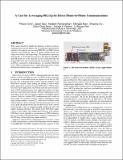A Case for Leveraging 802.11p for Direct Phone-to-Phone Communications
Author(s)
Choi, Pilsoon; Gao, Jason Hao; Ramanathan, Nadesh; Mao, Mengda; Xu, Shipeng; Boon, Chirn-Chye; Fahmy, Suhaib A.; Peh, Li-Shiuan; ... Show more Show less
DownloadPeh_A case RIGHT VERSION.pdf (1.252Mb)
OPEN_ACCESS_POLICY
Open Access Policy
Creative Commons Attribution-Noncommercial-Share Alike
Terms of use
Metadata
Show full item recordAbstract
WiFi cannot effectively handle the demands of device-to-device communication between phones, due to insufficient range and poor reliability. We make the case for using IEEE 802.11p DSRC instead, which has been adopted for vehicle-to-vehicle communications, providing lower latency and longer range. We demonstrate a prototype motivated by a novel fabrication process that deposits both III-V and CMOS devices on the same die. In our system prototype, the designed RF front-end is interfaced with a baseband processor on an FPGA, connected to Android phones. It consumes 0.02uJ/bit across 100m assuming free space. Application-level power control dramatically reduces power consumption by 47-56%.
Date issued
2014-08Department
Massachusetts Institute of Technology. Computer Science and Artificial Intelligence Laboratory; Massachusetts Institute of Technology. Department of Electrical Engineering and Computer ScienceJournal
Proceedings of the 2014 International Symposium on Low Power Electronics and Design (ISLPED '14)
Publisher
Association for Computing Machinery (ACM)
Citation
Pilsoon Choi, Jason Gao, Nadesh Ramanathan, Mengda Mao, Shipeng Xu, Chirn-Chye Boon, Suhaib A. Fahmy, and Li-Shiuan Peh. 2014. A case for leveraging 802.11p for direct phone-to-phone communications. In Proceedings of the 2014 international symposium on Low power electronics and design (ISLPED '14). ACM, New York, NY, USA, 207-212.
Version: Author's final manuscript
ISBN
978-1-4503-2975-0